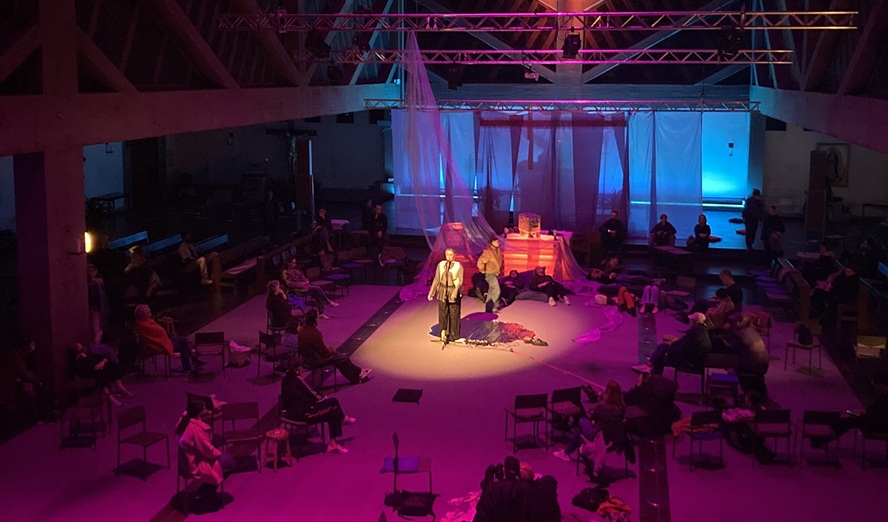How did this collaboration come together, what does your work as a trio look like?
Vladimir Miller: I was invited to work together with Meg and Philipp who have previously done a piece called »Maybe Forever«, also with a third person on stage, a Belgian musician. So it is a continuation of this kind of praxis, bringing a third person – in addition to the two dancers – on stage.
Philipp Gehmacher: We have worked with different artists like scenografists or artists specialised in video before.
Meg Stuart: We made this piece »Maybe Forever« and we were touring it. It is now four years old. Then it felt there is still another piece with more intimate body dialogue to be made … so there was something more to do. Few years ago we had a short residency in Salzburg. At that time we invited Vladimir and started to research.
PG: I think it is really a piece that came out of a meeting. Getting together in the same space, each of us proposing ideas and throwing them in there from our own pratice. It was not that kind of work with a score conceived. The gathering came out of a shared interest to meet and spent time together.
MS: We had this growing artistic concerns about putting the work into an art context. It was interesting for us to not just do a performance on stage but to work on something more like a performance installation.
PG: Coming from the performing arts doing a show together that one has to install and reinstall in different places and different buildings which is logistically not always so easy was really an interest of mine. That you can play on site. That doesn’t mean it is site-specific but you have real walls to deal with. It’s not a bare theater but it can become a bare space. You get into the white cube situation because of the video projection that has to work, but it would also work when white walls are rebuilt for us. So it doesn’t necessarily have to be the classical white cube context either.
The concept of space and void seems important for your works. How do you try to fill the void or produce void?
PG: I think in my work I have done a lot of pieces where I have stripped the theater stage sort of bare of all the theater paraphernalia like the curtain and everything: just a bare floor and walls to attain emptiness or void. Then questions pop up like: How to reinstantiate or instantiate movement, physical communication, physical states and physical interaction? With a visual artist like Vladimir coming in through projection, light and all kinds of media it doesn’t necessarily become a straight forward background that illustrates the hole space for a particular theme or aim. In »The Fault Lines« the input of Vladimir adds to a certain empty space in a very subtle way.
MS: We are exploring »stills« over many years. Especially in »Maybe Forever« we have done this »sculptural stills«. In »The Fault Lines« there is Vladimir manipulating and flickering light with this very expose means. He is proposing thought processes, questions on all different levels that are not necessarily revealed but are suggested. Not through movement but with projections and drawings.
How do you feel about using spoken words? How does it go along with the movement? How do you work with that in general?
MS: Somehow for me it is always – even if there is language involved – a dance proposal. Even if I am working with language I am still working on moving the discourse of dance or »dance as«. Where does language fail, where does movement stop or become interior or how is it exposed? A lot of our work is about stating things that are not explicit and easily readable.
What about the title of your new performance installation »The Fault Lines«?
MS: There is an undisclosed situation that is somehow re-examined and re-constructed. There are gaps in relationship to memory and information, in being too close to it whereas there is a need for a distance. On another level there are the lines between the video projection, the drawing, the hidden connections to life. There is no save territory, something could happen at any moment. It is something you presage but don’t experience at the moment. It is quite dangerous to build something on a »fault line«.
PG: It is a technical term actually, »Verwerfungslinie« in German.
VM: Yes, it’s a geological terminology: Where tectonic plates come together.
How important is theoretical research in general? Do you have to generate a certain amount of information before you start to work on something?
MS: It is different for everyone of us. We didn’t do a big sort of conceptual preparation for this work. We are working individually on obsessions, expressions … interests, discoveries on all levels … and then we bring it all to the studio.
PG: I think we all read a fair amount and have a large interest in theory. I like it when I work by myself. I don’t need a theoretical starting point or an academic research. I try to work as intuitively as I can at the moment, I try to push this process. I think it is important to say we all have our own histories but also know each others histories. I have seen Meg’s work since 1996. I know more or less 80 % of her works. Every time I look at her on stage – I know when a new movement appears that I like, that catches my eye. She also knows what I am up to. We do come with a whole load of stuff that we want to continue with, we know the discourses around our works. Partly we can try to leave it behind. It is a mix of both things: trying to find something new on the one side and trying to go on on the other side. We know what the other person stands for. All that comes into play when you work with someone you are interested in, you like for certain abilities: You maybe even want to push someone into a certain direction or you suggest they could do something they have not done before. That is very different than being more on the directors side and having performers to cope and collaborate, where you have to be more strictly direct.
How important is the architectual space you are performing in? Is it a kind of restriction?
PG: I don’t think it is a restriction. We just have to adapt every time.
VM: It is important for practical reasons. The projections need specific distances to the wall, they need specific lighting situations, specific wall colours. They need the architecture to be possible. We have to situate ourselves precisely in the space.
Why did you choose the MUMOK Factory for »The Fault Lines« and not a typical theatre space?
PG: Initiately it was because we wanted to make something intimate. We needed white walls for the projections because the black box theatre wouldn’t work for that. The beauty of the work is that it opened up a paradox situation. We found it interesting to be in a white cube setting, but at the same time we needed a wooden floor because we created a very physical scene that we could not do on concrete. The white cube frames the theatricality of this dance piece in a good way.
VM: I think there is a shared interest to continue exposing this spill over of dance and visual art to confront ourselves with this particularities of viewing. To see a different take on basic constructions like dramaturgy, to see a different culture of perception.
MS: It is an art space, a white cube but it is also a real room. Looking at the gallery as a room: It is a real place, even though it is neutral, where things are projected in to, on to it. We didn’t want a constructed, fake white cube in a theater space.
GH: Black box theater often doesn’t allow you to use its walls because there is a lot of technical stuff tucked away. It is much more like a podium. The focus goes to the centre of the stage whereas here we want to focus on and use the periphery. We appreciate the possibility to deal with the real architectural boundaries.



















